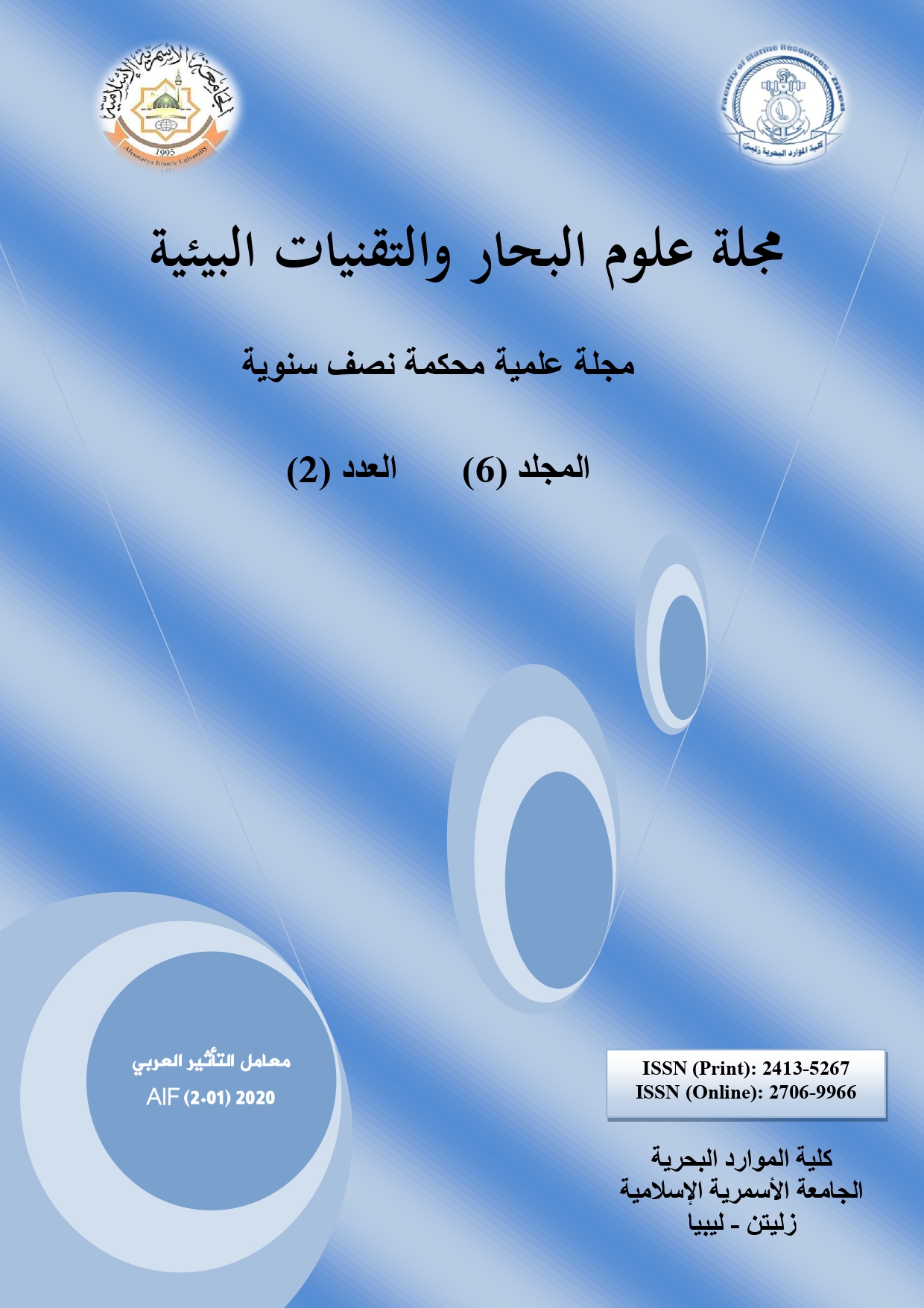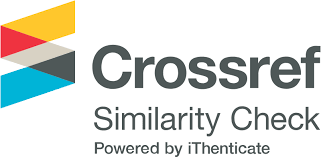التمعدن الحيوي في هياكل بعض الاسماك الغضروفية من سواحل سوسة ودرنة، ليبيا (دراسة تقديرية باستخدام تقنية النانو)
DOI:
https://doi.org/10.59743/jmset.v6i2.35الكلمات المفتاحية:
الغضروفيات، المتسولا، كلب بوشوكة، محراث، حرشاية داكنة، البقرة المدورة، الهيكل العظمي، التمعدن الحيوي، تقنية الاشعة المتفلورة، سواحل سوسة و درنة، ليبياالملخص
في الفترة من مارس إلى أبريل 2019، من ميناءي سوسة ودرنة، تم إحضار عينات خمسة أنواع من الأسماك الغضروفية: المتسولا Galeorhinus galeus، كلب بوشوكة Squalus acanthias، محراث Rhinobatus rhinobatus، حرشاية داكنة Raja clavata والبقرة المدورة Taeniura grabata لدراسة التمعدن الحيوي لهياكلها الغضروفية بواسطة تقنية الـ XRF على جهاز الــــ Bruker S2 Ranger 2008، وقد تراوحت كربونات الكالسيوم CaCO3 من 46.53٪ في المتسولا إلى 50.69٪ في البوشوكة. وقد بلغ CaO لدى الـ G. galeus أعلى قيمة (71.11٪) مقارنة مع قيمة دنيا لدى الـ T. grabata (69.03٪) والذي زادت فيه SO3 (16.2٪)، في حين انخفضت إلى 9.21٪ في R. clavata، وبنفس الرقم كانت أعلى نسبة فوسفات (P2O5)، والتي كانت أقل من 8٪ في G. galeus التي حملت أقل سيليكات (SiO2) (7.80٪). أيضا، كانت الحرشاية عالية في نسب أكاسيد المغنيسيوم والألومنيوم والحديد والمنجنيز في هذا العمل حتى 0.32 و0.26 و0.42 و0.89٪ على التوالي. كانت المتسولا صاحبة أقل كمية معادن في هياكلها حتى 37.39٪ بقدر ضئيل عن مجموع معادن هيكل البوشوكة (39.95٪). أيضًا، سجلت الـــــS. acanthias نسبة Ca/P مرتفعة (9.53: 1.00)، مقارنة بـ R. clavata (7.70: 1.00). هذه التحليلات مفيدة لفهم ومتابعة فسيولوجية التمعدن حيوي والتراكم الحيوي للمعادن في الكائنات البحرية في الساحل الليبي.
التنزيلات
المراجع
Abdallah (2007). Sharks and Rays of the Red Sea and the Gulf of Aden. FAO species Identification Cards. FAO, Rome, pp. 110.
Abu-Madinah H.M. (2008). The Libyan harbors–A study in the Economic geography, 2nd ed.. The international house of books, Benghazi, Libya, pp. 368.
Ali H.I. (2016). Estimate the chemical composition, functional groups and metal oxides in sediments and rocks marine samples by using Nanotechnology analysis (X-ray) and infrared spectra techniques. Faculty of sciences, Omar Al-Mukhtar University, Albayda, Libya, M.Sc. Thesis, pp. 76.
Al-Huni A.A.D., and Al-Kabier N. (1991). A photo guide for some economic fishes in the Libyan waters. Marine Biology Research Center (MBRC), Tajura'a, Tripoli, pp. 95.
Bahrololoom M.E., Javidi M., Javadpoura S., and Ma J. (2009). Characterisation of natural hydroxyapatite extracted from bovine cortical bone ash. Journal of Ceramic Processing Research, 10: 129-138.
Basusta N., Erdem Ü., and Kumlu M. (1998). Two new fish records for the Turkish seas: round stingray Taeniura grabata and skate stingray Himantura uarnak (Dasyatidae). ###### Journal of Zoology , 44: 65-66.
Bauchot M.L. (1987). Raies et autres batoides. p. 845-886. In W. Fischer, M.L. Bauchot and M. Schneider (eds.), Fiches FAO d'identificationpour les besoins de la pêche. (rev. 1). Mèditerranéeet mer Noire. Zone de pêche 37. Vol. II. Commission des Communautés Européennes and FAO, Rome.
Ben-Abdalla A.R., Al-Gmati H., Kasim A.A., Al-Turkie A.A., and Ben-Moussa M.N. (2012). Guide to cartilaginous fishes in Libyan waters. Marine biology Research Center (MBRC) - Tajoura’a, Tripoli, pp. 100.
Boskey A.L. (1998). Biomineralization: conflicts, challenges, and opportunities. Journal of Cellular Biochemistry. Supplement. 30–31: 83–91.
Bonucci E. (1992). Calcification in Biological Systems. CRC press, Boca Raton, FL, pp. 179-216.
Bradai M.N., Saidi B., and Enajjar S. (2012). Elasmobranchs of the Mediterranean and Black sea: status, ecology and biology bibliographic analysis. Studies and Reviews. General Fisheries Commission for the Mediterranean. No. 91. FAO, Rome, pp. 103.
Brito A. (1991). Catalogo de los pesces de las Islas Canarias. Francisco Lemus, la Laguna, pp. 230.
Buzaid E.M.K., and El-Mor M.E.E. (2015). Feeding Habits of the Copper Shark, Carcharhinus brachyurus (Günther, 1870) from Ain El-Ghazala Lagoon, Eastern Libya during the Period from February till June 2013. Journal of Life Sciences, 9: 347-355
Buzaid E.M.K. (2017). Morphological Aspects of Tope Shark Galeorhinus Galeus in Susah, Libya, from June to December 2016. Journal of Global Scientific Research, 2: 35–43.
Camhi M., Fowler S., Musick J., Bräutigam A., and Fordham S. (1998). The IUCN Species Survival Commission - Sharks and their Relatives, Ecology and Conservation. Occasional Paper of the IUCN Species Survival Commission No. 20, pp. 63.
Capapé C., and Desoutter M. (1981). Nouvelle description de Raja (Raja) clavata Linnaeus, 1758 et note sur la validité de Raja (Raja) capensis Müller et Henle, 1841. Cybium, 5(4): 23-39.
Carrier J.C., Musick J.A., and Heithaus M.R. (2004). Biology of sharks and their relatives. CRC marine biology series, IV. Series - Chondrichthyes, pp. 596.
Compagno L.J.V. (1984). FAO species catalogue. Vol. 4. Sharks of the world. An annotated and illustrated catalogue of shark species known to date. Part 2. Carcharhiniformes. FAO Fish. Synop., (125) Vol.4, FAO, Rome, pp. 269.
Copp D.H., Cockcroft D.W., and Kueh Y. (1967). Calcitonin from ultimobranchial glands of dogfish and chickens. Science, 158(3803): 924-925.
Corke J. (2012). Identification guide to sharks, Skates, Rays and Chimaeras of Atlantic Canada. WFF, Canada, pp. 143.
Cox G., and Francis M. (1997). Sharks and rays of New Zealand. Canterbury Univ. Press, Univ. of Canterbury, pp. 68.
Cuif J-P. Yannicke D., and James E.S. (2011). Biominerals and fossils through time. Cambridge press.
Currey J.D. (1999). The design of mineralised hard tissues for their mechanical functions. J. Exp. Biol., 202: 3285-3294.
Currey J.D. (2002). Bones. Princeton: Princeton University Press.
Dean M.N., and Summers A.P. (2006). Mineralized cartilage in the skeleton of chondrichthyan fishes. Zoology, 109: 164-168.
Desse J., Desse-Berset N., and Rocheteau M. (1989). Les profils rachidiens globaux. Reconstitution de la taille des poissons et appréciation du nombre minimal d’individus à partir des pièces rachidiennes. Revue de paléobiologie, 8: 89-94.
Dehaas W., and Knorr F. (1979). The Young Specialist Looks At Marine Life, (Translated by Heather J. Fisher), Burke Publishing Company Limited, London, pp. 356.
Enault S., Auclair C., Adnet S., and Debiais‐Thibaud M. (2016). A complete protocol for the preparation of chondrichthyan skeletal specimens. Journal of Applied Ichthyology, 32: 409-415.
Froese R., and Pauly D. (2009). Taeniura grabata in Fish Base. November 2009 version.
Golani D., Öztürk B., and Basusta B. (2006). Fishes of the Eastern Mediterranean. Turkish Marine Research Foundation, 264.
Goldstein S.A. (1987). The mechanical properties of trabecular bone: dependence on anatomic location and function. J. Biomech., 20: 1055–1061.
Harris E.D. (2014). Minerals in Food Nutrition, Metabolism, Bioactivity, 1st ed.. Lancaster, PA: DEStech Publications Inc., p. 378.
Hildebrand M. (1968). Anatomical preparations. University of California Press, Berkeley, pp. 100.
Iglésias S.P. (2006). Chondrichthyans from the North-eastern Atlantic and the Mediterranean - A natural classification based on collection specimens - plates & text, Vol. 2. (In French)
Jacob D.E., Wirth R., Agbaje O.B.A., Branson O., and Eggins S.M. (2017). Planktic foraminifera form their shells via metastable carbonate phases. Nature Communications, 8 (1): 1265.
Knoll A.H. (2003). Biomineralization and evolutionary history. Reviews in mineralogy and geochemistry, 54(1): 329-356.
Kubo Y., and Asano H. (1987). Growth type of vertebral centra and the hard tissue observed by microradiography of the rainbow trout. Nippon Suisan Gakkaishi, 53: 1367-1372.
La-Tour T. (1989). Analysis of rocks using X-Ray Fluorescence Spectrometry. The Rigaku Journal, 6: 3 – 9.
Last P.R.. White W.T., De Carvalho M.R., Séret B., Stehmann M.F.W., and Naylor G.J.P. (2016). Rays of the world. CSIRO Publishing, Comstock Publishing Associates. i-ix + 1-790.
Le Danois Y. (1958). Système musculaire. In: Grassé, P.P. (eds.), Masson, Paris. Traité de Zoologie, 13: 783-817.
Learm J. (1976). The development, function, and design of amphicoelous vertebrae in teleost fishes. Zoological Journal of Linnaean Society, 58: 237-254.
Lindsey C.C. (1978). Form, function and locomotory habits in fish. IN: Hoar, W. S., Randall, D. J. (eds.). Fish Physiology, Academic Press, New York, pp.1-100.
Louw G.N., Stahl P.D., and Kenny A.D. (1969). Thyrocalcitonin studies in elasmobranch fish. Zool. Afr., 4: 95-98.
Macesic L.J., and Summers A.P. (2012). Flexural stiffness and composition of the batoid propterygium as predictors of punting ability. Journal of Experimental Biology, 215: 2003-2012.
Mass Tali; Giuffre, Anthony J.; Sun, Chang-Yu; Stifler, Cayla A.; Frazier, Matthew J.; Neder, Maayan; Tamura, Nobumichi; Stan, Camelia V.; Marcus, Matthew A.; Gilbert, Pupa U. P. A. (2017). Amorphous calcium carbonate particles form coral skeletons, Proceedings of the National Academy of Sciences, 114(37): E7670–E7678.
MBRC (2005). Atlas of the Mediterranean Sea, Marine Biology Research Center (MBRC), Tajura'a, Tripoli, pp. 135.
McEachran J.D., and Capape C. (1989). Dasyatidae. In Whitehead, P.J.P. Fishes of the North-eastern Atlantic and the Mediterranean, Vol. 1. UNESCO. pp. 197–202.
McEachran J.D., and Capapé C. (1984). Dasyatidae. p. 197-202. IN: P.J.P. Whitehead, M.-L.Bauchot, J.-C.Hureau, J. Nielsen and E. Tortonese (eds.) Fishes of the north-eastern Atlantic and Mediterranean, Vol. 1. UNESCO, Paris.
McCalden R.W., McGeough J.A., and Court-Brown C.M. (1997). Agerelated changes in compressive strength of cancellous bone. The relative importance of changes in density and trabecular architecture. J. Bone Joint Surg., 79: 421-429.
Michael S.W. (1993). Reef sharks and rays of the world. A guide to their identification, behavior, and ecology, Sea Challengers, Monterey, California, pp. 107.
Milhaud G., Rankint J. C., Bolist L., and Benson A.A. (1977). Calcitonin: Its hormonal action on the gill (calcium influx/phosphate influx/flow rate/norepinephrine/B-adrenergic receptors), Physiological Sciences, Proc. Natl. Acad. Sci. USA, 74: 4693-4696.
Moss M.L. (1977). Skeletal tissues in sharks. Am. Zool., 17: 335-342.
Muus B.J., and Nielsen J.G. (1999). Die Meeresfische Europas in Nordsee, Ostsee und Atlantik. Kosmos, pp. 336.
Neues F., Hild S., Epple M., Marti O., and Ziegler A. (2011). Amorphous and crystalline calcium carbonate distribution in the tergite cuticle of moulting Porcellio scaber (Isopoda, Crustacea), Journal of Structural Biology, 175(1): 10–20.
Onozato H. (1979). Studies on fish scale formation and resorption. Cell and Tissue Research, 201(3): 409–422.
Pang P.K.T., and Pickford G.E. (1967). Failure of hog thyrocalcitonin to elicit hypocalcemia in the teleost fish, Fundulus heteroclitus. Comp. Biochem. Physiol., 21:,573-578.
Parker T.J. (1981). On a new method of preserving cartilaginous skeletons and other soft animal structures, Trans. Proc. R. Soc. N. Z., 14: 258–264.
Pokroy B., Kabalah-Amitai L., Polishchuk I., DeVol R.T., Blonsky A.Z., Sun C., Marcus M.A., Scholl A., and Gilbert P.U.P.A. (2015). Narrowly Distributed Crystal Orientation in Biomineral Vaterite, Chemistry of Materials, 27(19): 6516–6523.
Porter M.E., Beltrán J.L., Koob T.J., and Summers A.P. (2006). Material properties and biochemical composition of mineralized vertebral cartilage in seven elasmobranch species (Chondrichthyes), The Journal of Experimental Biology, 209: 2920-2928
Raoult V., Peddemors V.M., Zahra D., Howell N., Howard D.L., De Jonge M.D., and Williamson J.E. (2016.) Strontium mineralization of shark vertebrae, Scientific RepoRts, 6: 29698.
Reiner F. (1996). Catálogo dos peixes do arquipélago de Cabo Verde. Publ. Avuls. Inst. Port. Invest. Mar, 2: 339.
Reynolds J.E., and Abukhader A., and Ben-Abdallah A. (1995). The marine wealth sector of Libya: a development planning overview, Food and Agriculture Organization (FAO), Division of Fishery and Aquaculture Economics and Policy Division, Tripoli/Rome.
Ridewood W.G. (1921). On the calcification of the vertebral centra in sharks and rays. Philos. Trans. R. Soc. Lond. B Biol. Sci., 210: 311-407.
Riede K. (2004). Global register of migratory species - from global to regional scales. Final Report of the R&D-Projekt 808 05 081. Federal Agency for Nature Conservation, Bonn, Germany, pp. 329.
Sarikaya M. (1999). Biomimetics: Materials fabrication through biology. Proceedings of the National Academy of Sciences of the United States of America, 96 (25): 14183–14185.
Serena F. (2005). Field identification guide to the sharks and rays of the Mediterranean and Black Sea. FAO Species Identification Guide for Fishery Purposes, Rome, FAO, pp. 97.
Shah K.M., Goh J.C.H., Karunanithy R., Low S.L., De Das S., and Bose K. (1995). Effect of decalcification on bone mineral content and bending strength of feline femur. Calcif. Tissue Int. 56: 78-82.
Sigel A.. Helmut S., Rol K., and Sigel O. (2008). Biomineralization: From Nature to Application. Metal Ions in Life Sciences, Wiley.
Skinner H.C.W. and Jahren A.H. (2007). Biomineralization, in Biogeochemistry, 2nd ed. vol. 8, Schlesinger, W.H. Treatise on Geochemistry, Oxford, Elsevier-Pergamon, Ch. 4, pp. 1-69.
Stehmann M. (1990). Rajidae. p. 29-50. IN: J.C. Quero, J.C. Hureau, C. Karrer, A. Post and L. Saldanha (eds.) Check-list of the fishes of the eastern tropical Atlantic. Junta Nacional de Investigaçao Cientifica e Tecnológica, Lisbon, Portugal. Vol. 1.
Summers A.P. (2000). Stiffening the Stingray Skeleton - An Investigation of Durophagy in Myliobatid Stingrays (Chondrichthyes, Batoidea, Myliobatidae), Journal of Morphology, 243:113–126.
Summit D.J. (2012). Dangerous creatures of the Maltese sea: Injuries and treatment - Part 1. The Journal of the Malta College of Family Doctors, 1(2): 28-33.
Vengadesan R., and S. Kumar G.R. (2016). Comparative study on chemical characteristics and biominerals in Meretrix casta (Chemnitz, 1782) shells of Vellar and Yadayanthittu estuaries, Southeast coast of India. IJARBEST, 2(4): 7-15.
Vert M., Doi Y., Hellwich K., Hess M., Hodge P., Kubisa P., Rinaudo M., and Schué F.S. (2012). Terminology for biorelated polymers and applications (IUPAC Recommendations 2012). Pure and Applied Chemistry, 84(2): 377–410.
Vinn O. (2013). Occurrence formation and function of organic sheets in the mineral tube structures of Serpulidae (Polychaeta Annelida). PLoS ONE, 8 (10): e75330.
Vronskii A.A., and Nikolaitchouk L.A. (1989). Morphologie function, nelle de la musculature locomotrice du corps des poisons. Live; LaPensée Scientifique, pp. 184 (In Russian).
Walker P., Howlett G., and Millner R. (1997). Distribution, movement and stock structure of three ray species in the North Sea and eastern English Channel. ICES Journal of Marine Science, 54: 797-808.
Walker T.I., Cavanagh R.D., and Stevens J.D. (2006). Galeorhinus galeus. In: 2008 IUCN Red List of Threatened Species. Available online at: [www.iucnredlist.org].
Weihs D. (1989). Design features and mechanics of axial locomotion in fish. American Zoologist, 24: 151-160.
Weiner S., and Lowenstam H.A. (1989). On biomineralization. Oxford University Press.
Wheeler A., and Stebbing P. (1978). Key to fishes of northern Europe. London, pp. 380.
White W.T., Yearsley G.K., and Last P.R. (2007). Clarification of the status of Squalus taiwanensis and a diagnosis of Squalus acanthias from Australia, including a key to the Indo-Australasian species of Squalus. pp. 109-115. IN: P.R. Last, W.T. White and J.J. Pogonoski Descriptions of new dogfishes of the genus Squalus (Squaloidea: Squalidae). CSIRO Marine and Atmospheric Research Paper No. 014, pp. 130.
Whitehead P.J.P., Bauchot J.C., Hureau J.C., Nielsen J., and Tortonese E. (1984). Fishes of the North eastern Atlantic and Mediterranean. Published by the United Nations Educational, Scientific and Cultural Organization. United Kingdom. UNESCO.
التنزيلات
منشور
إصدار
القسم
الرخصة
الحقوق الفكرية (c) 2020 مجلة علوم البحار والتقنيات البيئية

هذا العمل مرخص بموجب Creative Commons Attribution 4.0 International License.












